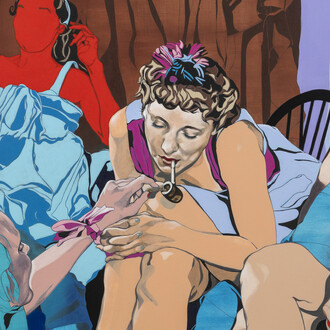Akinci is proud to present the first solo exhibition by Ethiopian experimental printmaker Tiemar Tegene (1993, Addis Ababa). Entitled Mirror, mirror on the wall, who’s the darkest of them all?, the exhibition presents recently created monoprints which, contrary to what the definition of a print suggests, are all unique, multi-layered works. This exhibition not only provides insight into the experimental nature of Tegene’s work through her reinvention of the technique, but also tells personal and universal stories of identity and memory.
Building on her solid mastery of traditional printmaking techniques, Tegene began to work in an increasingly experimental and conceptual manner. She traded the iron plate on which she initially worked for a piece of plastic. Her most frequently used tool is a wooden spoon that she sharpens to a point like a pencil. Using this and other tools, a painting is first created on a plastic sheet which is then printed against the back of a stretched painting canvas, pressing the sides of the plastic against the edges of the inverted frame. Different textures and materials such as painted lace are applied by pressing them on the canvas.
Tegene prefers to work with the colour black, she values its expressiveness, and the power and strength it symbolises. Emphasising the colour black counters any negative connotations; instead of representing absence, it signifies a strong presence and a vital force. It questions the persistent association of darkness with evil, cruelty and ignorance, and therefore finds itself in the eternal dialogue from which history of mankind is written. In an interplay between absence and presence, meaning is given to the negative space in the works.
Inspiration for the subjects of Tegene’s monoprints is often drawn from seeing a film or listening to stories from friends or random strangers on the streets. Her creative process is accompanied by music, the lyrics of which can also act as a source of inspiration. The personal, individual stories represent a larger, universal story that she hopes people can relate to. In these works that contain both abstract and figurative elements, Tegene transforms complex emotions, such as loss, nostalgia and hope, into a visual, tangible world.
Taking a process-oriented approach involving unconventional materials, non-traditional techniques and inventive compositions, Tegene’s work defies categorisation. With her unique interpretation of printmaking, she challenges existing art world hierarchies, in which prints are often considered inferior due to their reproducibility. By questioning this hierarchy, she reveals the ever-changing narrative of history as a negotiation between the present and the past. Tegene’s technique, combined with her expressive use of the colour black, can be seen as a subtle yet revolutionary act of resistance.















